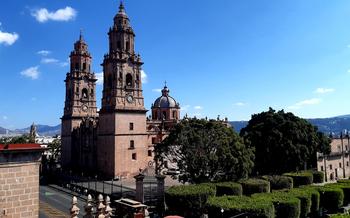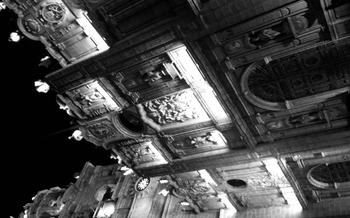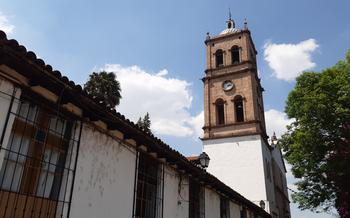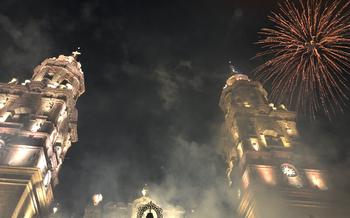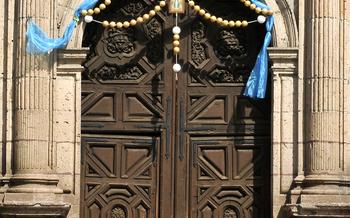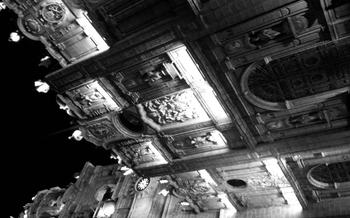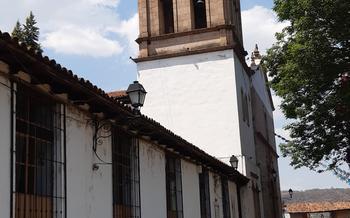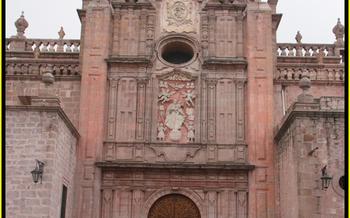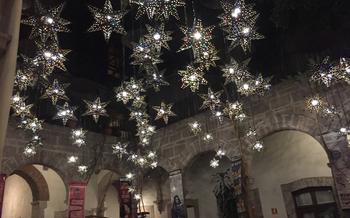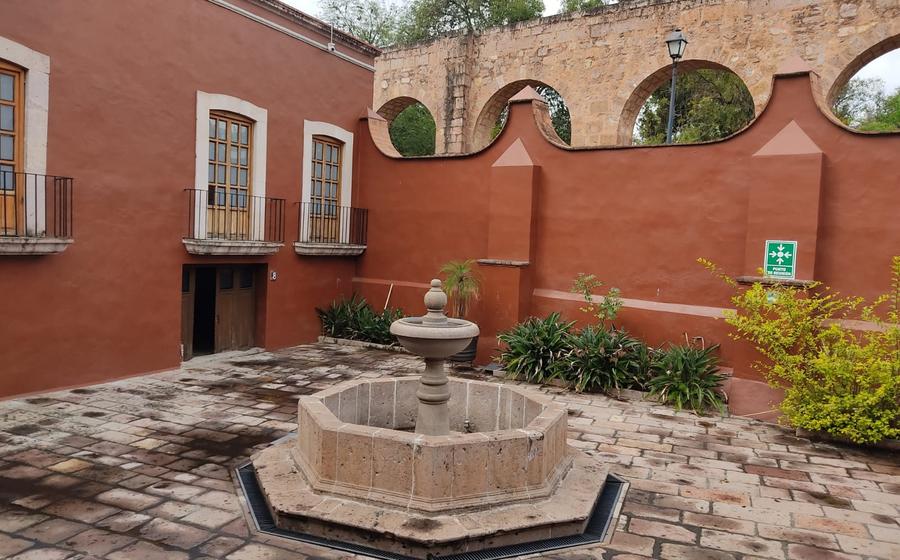
Museo de Artes e Industrias Populares en Pátzcuaro
- Location and Accessibility
- Permanent Collection Highlights
- Temporary Exhibitions and Events
- Interactive Exhibits and Activities
- Shopping and Souvenirs
- Architecture and Design
- Cultural Significance and Impact
- Community Engagement and Partnerships
- Research and Publications
- Awards and Recognition
- Accessibility and Inclusivity
- Future Plans and Developments
- Insider Tip: Secret Spot for Panoramic Views
Location and Accessibility
The Museo de Artes e Industrias Populares en Pátzcuaro is conveniently located in the heart of the city, just a Pátzcuaro, Michoacán.
Reaching the museum is easy and accessible by various means of transportation. For those arriving by car, there is limited street parking available in the surrounding area. However, it's recommended to use the public parking lot located a few blocks away to ensure a hassle-free experience.
For those utilizing public transportation, there are several bus routes that stop within walking distance of the museum. Simply ask the bus driver or locals for directions to the "Museo de Artes e Industrias Populares."
The museum is wheelchair accessible and has ramps and elevators throughout the building, ensuring that visitors with disabilities can comfortably navigate and enjoy the exhibitions.
Permanent Collection Highlights
The Museo de Artes e Industrias Populares en Pátzcuaro houses a remarkable permanent collection that showcases the diverse and vibrant traditions of Mexican folk art. Among the must-see artifacts and artworks are intricate lacquerware pieces from Uruapan, known for their vibrant colors and intricate designs. Visitors can marvel at the delicate hand-painted ceramics from Tonalá, each piece a testament to the skill and artistry of the local artisans.
The collection also features a stunning array of textiles from various regions of Mexico. Visitors can admire the intricate embroidery and colorful patterns of the Otomi people, as well as the traditional rebozos and sarapes from Saltillo. The museum also houses a collection of traditional Mexican masks, used in festivals and celebrations throughout the country. These masks represent a fusion of indigenous and Spanish influences and are a testament to the rich cultural heritage of Mexico.
Beyond these highlights, the permanent collection offers a glimpse into the diverse techniques and materials used by Mexican artisans. Visitors can learn about the ancient art of amate papermaking, the intricate process of metalworking, and the delicate craft of glassblowing. The museum's curatorial themes and storytelling help visitors understand the cultural significance of each artifact, showcasing how these crafts are deeply rooted in Mexican traditions, history, and identity.
Temporary Exhibitions and Events
The Museo de Artes e Industrias Populares en Pátzcuaro continuously hosts a variety of temporary exhibitions and events that showcase the diverse talents of local and national artisans. These exhibitions often focus on specific themes, techniques, or regions, providing visitors with a deeper understanding of Mexican craftsmanship.
In addition to exhibitions, the museum also organizes special events, workshops, and demonstrations that allow visitors to engage with the artisans and learn about their processes firsthand. These events may include traditional dance performances, craft demonstrations, hands-on workshops, and educational talks.
The museum actively collaborates with local artists and artisans to create unique and immersive experiences for visitors. Temporary installations and performances often bring the museum's collection to life, offering visitors a multisensory experience that celebrates Mexican culture and creativity.
Interactive Exhibits and Activities
The Museo de Artes e Industrias Populares en Pátzcuaro offers a range of interactive experiences that bring the museum's collection to life. Visitors can engage in hands-on activities, participate in educational programs, and even learn traditional crafts from local artisans.
One of the highlights of the museum is the demonstration area, where visitors can watch skilled artisans create beautiful objects using traditional techniques. The demonstrations cover a variety of crafts, including pottery, weaving, woodworking, and metalworking. Visitors can observe the artisans' intricate skills and ask questions about their processes.
For those who want to try their hand at traditional crafts, the museum offers a variety of workshops and classes. These workshops are led by experienced artisans who teach participants the basics of a particular craft. Visitors can learn to make pottery, weave textiles, or create jewelry using traditional methods.
The museum also offers educational programs for children and families. These programs include guided tours, art classes, and interactive activities that teach children about Mexican culture and traditions. The museum's goal is to inspire the next generation of artisans and craftspeople.
Through its interactive exhibits and activities, the Museo de Artes e Industrias Populares en Pátzcuaro provides visitors with a unique and immersive experience. Visitors can learn about traditional crafts, witness the skills of master artisans, and even create their own works of art.
Shopping and Souvenirs
The museum houses a charming shop where visitors can purchase authentic Mexican crafts and souvenirs. This is an excellent opportunity to support local artisans and take home a piece of Mexican culture. The shop features a wide range of products, including handmade pottery, textiles, jewelry, wood carvings, and more. Each item is carefully selected for its quality and uniqueness, showcasing the diverse talents of Mexican artisans.
When shopping at the museum, visitors can expect to find a variety of traditional crafts and techniques represented. These include intricate embroidery, colorful beadwork, traditional weaving, and hand-painted ceramics. The shop also features contemporary interpretations of traditional designs, offering a modern twist on Mexican craftsmanship.
Purchasing souvenirs from the museum is not just a way to acquire beautiful and unique items but also a way to contribute to the preservation of Mexican cultural heritage. The proceeds from sales directly support local artisans and communities, helping to ensure that traditional crafts continue to thrive.
When choosing souvenirs, consider items that are not only aesthetically pleasing but also have a story behind them. Ask the shop staff about the artisans who created the pieces, their techniques, and the cultural significance of their work. This will help you make informed choices and ensure that your souvenirs are truly meaningful and memorable.
Architecture and Design
The Museo de Artes e Industrias Populares en P it contains. The museum's architecture seamlessly blends traditional Mexican elements with modern design, creating a unique and visually striking space. The original building, constructed in the 17th century, was renovated and expanded in the 1970s by renowned Mexican architect Pedro Ramírez Vázquez.
The museum's exterior features a striking façade adorned with intricate stone carvings and colorful tiles, reflecting the vibrant artistic traditions of Mexico. Upon entering the museum, visitors are greeted by a spacious courtyard with a central fountain, surrounded by arched walkways and balconies. The courtyard provides a glimpse into the museum's diverse collection of Mexican crafts, with colorful textiles, pottery, and other artifacts displayed throughout the space.
The museum's interior spaces are designed to showcase the beauty and diversity of Mexican artesanía. The galleries are well-lit and airy, allowing visitors to fully appreciate the intricate details and craftsmanship of the exhibits. Modern display cases and interactive elements complement the traditional architecture, creating a dynamic and engaging environment for visitors to explore.
Throughout the museum, visitors will find thoughtful touches that highlight the cultural significance of the collections. Traditional Mexican motifs and symbols are incorporated into the design of the building, creating a sense of continuity between the past and the present. The museum's architecture and design work together to create a truly immersive experience, allowing visitors to fully appreciate the richness and diversity of Mexican folk art.
Cultural Significance and Impact
The Museo de Artes e Industrias Populares en Pátzcuaro plays a crucial role in preserving and promoting Mexico's rich cultural heritage. Through its collection of traditional crafts and artworks, the museum showcases the skill and artistry of Mexican artisans, highlighting the diverse cultural traditions and techniques that have been passed down for generations.
The museum's educational and cultural programs further contribute to its impact by raising awareness about the importance of traditional crafts and fostering an appreciation for Mexican folk art. Workshops, demonstrations, and exhibitions engage visitors of all ages, providing a deeper understanding of the cultural significance and symbolism behind the various crafts.
By preserving and promoting traditional crafts, the museum helps to sustain the livelihoods of local artisans and their communities. The sale of authentic crafts in the museum shop directly supports these artisans, enabling them to continue practicing their traditional skills and preserving their cultural heritage.
Furthermore, the museum's focus on traditional crafts contributes to the local economy and tourism. By attracting visitors interested in learning about and purchasing authentic Mexican crafts, the museum generates revenue that benefits the local community and promotes sustainable tourism practices.
Community Engagement and Partnerships
The Museo de Artes e Industrias Populares en Pátzcuaro is deeply committed to community engagement and partnerships. It recognizes the vital role that local artisans and communities play in preserving and promoting Mexican cultural heritage. Through various initiatives and collaborations, the museum strives to empower local artisans, foster a sense of pride and cultural identity, and create a sustainable ecosystem for traditional crafts.
One of the museum's key initiatives is to collaborate closely with local artisans and communities to ensure that their voices and perspectives are represented in the museum's exhibitions and programs. The museum works directly with artisans to document their techniques, stories, and traditions, ensuring that their knowledge and skills are preserved and shared with future generations.
The museum also engages in community-based projects and initiatives that aim to support and empower local artisans. These projects may include training programs, marketing assistance, and opportunities for artisans to showcase and sell their products at the museum shop or through other channels.
By fostering these partnerships and collaborations, the Museo de Artes e Industrias Populares en Pátzcuaro plays a crucial role in supporting the livelihoods of local artisans, promoting traditional crafts, and strengthening the cultural identity of the Pátzcuaro region.
Research and Publications
The museum houses a well-established research center and library dedicated to the study and documentation of Mexican folk art. Researchers, scholars, and students can access a wealth of resources, including books, journals, photographs, and artifacts. The museum also publishes research papers, catalogs, and books on various aspects of Mexican crafts and culture.
Collaboration with universities and research institutions is a key component of the museum's research initiatives. These partnerships facilitate interdisciplinary research, promote knowledge sharing, and contribute to the advancement of scholarship in the field of Mexican folk art.
The museum's research and publications play a vital role in preserving and promoting Mexican cultural heritage. They provide valuable insights into the techniques, traditions, and significance of Mexican crafts, contributing to a deeper understanding and appreciation of this rich cultural expression.
Awards and Recognition
The Museo de Artes e Industrias Populares en Pátzcuaro has received numerous prestigious awards and accolades, both nationally and internationally, for its outstanding contributions to the preservation and promotion of Mexican cultural heritage. These accolades serve as a testament to the museum's dedication to showcasing the exquisite craftsmanship and traditions of Mexico's indigenous communities.
In 2010, the museum was honored with the prestigious National Award for Arts and Sciences in the category of Popular Arts and Traditions. This award is the highest recognition bestowed upon individuals and institutions that have made significant contributions to the preservation and dissemination of Mexican folk art.
The museum's exceptional work has also been recognized abroad. In 2015, it received the International Award for Museums from the International Council of Museums (ICOM), the world's largest organization of museums and museum professionals. This prestigious award recognizes museums that have demonstrated innovative approaches to museology and have made significant contributions to their communities.
These awards and recognitions underscore the Museo de Artes e Industrias Populares en Pátzcuaro's stature as a world-class institution dedicated to promoting and preserving the rich cultural heritage of Mexico.
Accessibility and Inclusivity
The Museo de Artes e Industrias Populares en Pátzcuaro is committed to providing an accessible and inclusive environment for all visitors. The museum features ramps, elevators, and accessible restrooms to ensure that visitors with disabilities can fully enjoy the museum's exhibitions and programs. Guided tours and educational programs are also available in sign language and Spanish, upon request.
The museum staff is dedicated to making the museum welcoming and inclusive for visitors of all ages, backgrounds, and abilities. Interpretive materials are available in multiple languages, and museum docents are trained to provide assistance and information to visitors with diverse needs.
The museum's efforts to promote accessibility and inclusivity have been recognized and appreciated by visitors from around the world. The museum has received numerous awards for its commitment to serving diverse audiences, including the National Award for Accessibility from the Mexican government.
Future Plans and Developments
The Museo de Artes e Industrias Populares en Pátzcuaro is continuously evolving to meet the changing needs of visitors and to preserve and promote Mexican cultural heritage. Future plans and developments for the museum include:
-
Expansion and Renovations: The museum is planning to expand its exhibition space and renovate existing galleries to improve the visitor experience. This will allow for the display of more artifacts and artworks, as well as the creation of new interactive exhibits and educational programs.
-
New Exhibitions and Programs: The museum is working on developing new exhibitions and programs that will explore different aspects of Mexican folk art and culture. These exhibitions may focus on specific regions, techniques, or themes, and will provide visitors with a deeper understanding of the rich diversity of Mexican crafts.
-
Sustainability and Conservation: The museum is committed to sustainability and conservation efforts to ensure the preservation of Mexican cultural heritage for future generations. This includes the use of energy-efficient lighting and climate control systems, as well as the implementation of conservation practices for artifacts and artworks.
-
Community Engagement: The museum plans to strengthen its partnerships with local artisans and communities to support their work and promote their products. This may include providing training and marketing assistance, as well as organizing workshops and events that celebrate traditional crafts and their importance to Mexican culture.
Insider Tip: Secret Spot for Panoramic Views
For a breathtaking perspective of Pátzcuaro and the surrounding lake, venture to the museum's hidden viewpoint. Nestled amidst lush gardens, this secluded spot offers a serene escape from the bustling city. Capture panoramic shots of the colonial rooftops, the shimmering lake, and the distant mountains. As you soak in the beauty of this hidden gem, let the tranquility of the surroundings transport you to a place of peace and serenity. To reach the viewpoint, follow the signs from the museum's main entrance or ask a staff member for directions. Remember to bring your camera to capture this unforgettable vista, and enjoy a moment of tranquility amidst the vibrant cultural heritage of Mexico.
